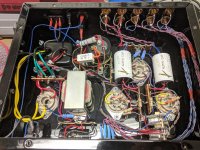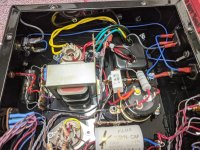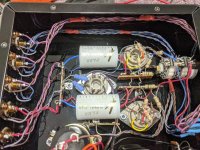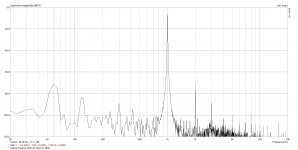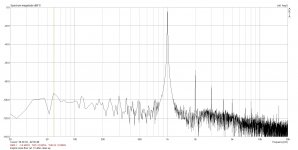Just finished building an Aleph J with the help of all the good folks here and now that it's done, it apparently has a little more gain than my other amp which uses 45's, and the preamp buzz/hum that it's always had, is now a little bothersome to me and very noticeable during a lot of songs. I'm primarially picking up 120hz buzz but also see a bit of 60hz hum on a spectrum analyzer app.
I've tried the usual stuff on the outside with cheater plug/humx, moving things around, rolling tubes, cables, there are no lights nearby, etc. I do have another couple of rectifier tubes coming thinking that maybe the 5Y3G envelope might help over the regular slender envelope.
Anyway, after poking around inside it looks like the heater wires are all done up reasonably OK after reading that thread here on good wiring practices. I'm wondering about the Hot AC run from the IEC to the switch and from the switch to the transformer. While they're both live, they are running in opposite directions, should I twist those? The rectifier filament wires are twisted, but could be one or two turns tighter, should I bother? I have a hard time thinking this is the cause. Same on the rectifier plates?
I've noted that the main power switch and center 6SN7 base arent grounded. There's also a bit of daisy chain going on with connecting all the grounded points together at all the distribution strips. (what's the proper term for those?) Seems like a high chance for a ground loop; I'd like to attempt to fix it but a lot of things are glued/potted to the chassis so it will be hard to get at everything.
Another person with this amp noted they created a ground clip that they attached to the preamp chassis to their source that killed the hum dead.
Any other thoughts? Am I thinking right here? Have been trying to get in contact with the builder without any luck unfortunately.
I've tried the usual stuff on the outside with cheater plug/humx, moving things around, rolling tubes, cables, there are no lights nearby, etc. I do have another couple of rectifier tubes coming thinking that maybe the 5Y3G envelope might help over the regular slender envelope.
Anyway, after poking around inside it looks like the heater wires are all done up reasonably OK after reading that thread here on good wiring practices. I'm wondering about the Hot AC run from the IEC to the switch and from the switch to the transformer. While they're both live, they are running in opposite directions, should I twist those? The rectifier filament wires are twisted, but could be one or two turns tighter, should I bother? I have a hard time thinking this is the cause. Same on the rectifier plates?
I've noted that the main power switch and center 6SN7 base arent grounded. There's also a bit of daisy chain going on with connecting all the grounded points together at all the distribution strips. (what's the proper term for those?) Seems like a high chance for a ground loop; I'd like to attempt to fix it but a lot of things are glued/potted to the chassis so it will be hard to get at everything.
Another person with this amp noted they created a ground clip that they attached to the preamp chassis to their source that killed the hum dead.
Any other thoughts? Am I thinking right here? Have been trying to get in contact with the builder without any luck unfortunately.
Attachments
Last edited:
It seems you have several ground lugs used on the mouting strips instead of a central DC and audio grounding and the chassis and mains ground are directly connected to the same ground. So you may have ground loops. You could perhaps try to elevate the heater to reduce hum (some 50 to 100 volt DC). Google for heater elevation if you’re not sure how to do this.
Checking for hum in a working amplifier can be a time consuming job, but it has to be done.
Regards, Gerrit
Checking for hum in a working amplifier can be a time consuming job, but it has to be done.
Regards, Gerrit
Yes, all those center-lug-grounded terminal strips are the problem.
Those would all have to be lifted from ground, and instead connected to one appropriate central point.
A nasty job to do. This practice was found to be flawed 50 years ago, even though it's still done by some.
Those would all have to be lifted from ground, and instead connected to one appropriate central point.
A nasty job to do. This practice was found to be flawed 50 years ago, even though it's still done by some.
Last edited:
Thanks all.
Will look into what's required for elevating the ac heaters.
I heard back through a 2nd hand source that discussed this with the builder who claims grounding at the individual terminal strips is part of the design and sonic qualities. Further, because the chassis is aluminum, i.e. highly conductive, and each of the center tabs of these strips are ALSO directly grounded to each other with a section of soldered wire, they don't believe this is causing my hum and are telling me not to touch anything with respect to its grounding scheme.
I did try someone's suggestion of adding a direct chassis ground wire between preamp and dac or preamp and amp but that made no difference. Everything was already at very low resistance to each other.
Are there any thoughts about twisting those two runs of hot AC in from the IEC to the switch and from the switch to the transformer or twisting the leads to the rectifier tighter making any difference? Clearly I could just try it and let you but sounds like you all think I have other issues to sort through first.
Thanks
Will look into what's required for elevating the ac heaters.
I heard back through a 2nd hand source that discussed this with the builder who claims grounding at the individual terminal strips is part of the design and sonic qualities. Further, because the chassis is aluminum, i.e. highly conductive, and each of the center tabs of these strips are ALSO directly grounded to each other with a section of soldered wire, they don't believe this is causing my hum and are telling me not to touch anything with respect to its grounding scheme.
I did try someone's suggestion of adding a direct chassis ground wire between preamp and dac or preamp and amp but that made no difference. Everything was already at very low resistance to each other.
Are there any thoughts about twisting those two runs of hot AC in from the IEC to the switch and from the switch to the transformer or twisting the leads to the rectifier tighter making any difference? Clearly I could just try it and let you but sounds like you all think I have other issues to sort through first.
Thanks
No, that's just a lame garbage excuse for a poorly executed build. You don't want signal currents, power supply currents, nor magnetic eddy currents flowing uncontrolled through your chassis.I heard back through a 2nd hand source that discussed this with the builder who claims grounding at the individual terminal strips is part of the design and sonic qualities.
It's time to stop talking to whoever you're talking to and find someone else who isn't spouting nonsense. You can look at a Heathkit W5M manual from 1955 to see a relatively early example of how this was dealt with properly. Yes, this knowledge is at least that old. Yes, there are still people to this day who ignore it anyway.
If you post your approximate location in the world, we might be able to set you up with someone locally who can isolate all but one of those middle lugs, then make a star or ground buss for you to quiet this thing down.
Please do not hesitate to forward this to whoever you are talking to, they are not being helpful at all.
No, that's just a lame garbage excuse for a poorly executed build. You don't want signal currents, power supply currents, nor magnetic eddy currents flowing uncontrolled through your chassis.
It's time to stop talking to whoever you're talking to and find someone else who isn't spouting nonsense. You can look at a Heathkit W5M manual from 1955 to see a relatively early example of how this was dealt with properly. Yes, this knowledge is at least that old. Yes, there are still people to this day who ignore it anyway.
If you post your approximate location in the world, we might be able to set you up with someone locally who can isolate all but one of those middle lugs, then make a star or ground buss for you to quiet this thing down.
Please do not hesitate to forward this to whoever you are talking to, they are not being helpful at all.
Funny you ask, I'm in Seattle too.
Thanks for the candid advice.
I am happy to fix your preamp and post what I do to fix it for you here if you'd like.
I just went through this exercise with a guy out in Maple Valley who had a similar problem.
I just went through this exercise with a guy out in Maple Valley who had a similar problem.
That would be pretty incredible, especially if I could help or be supervised a bit. This would only be my 2nd ever thing after building an aleph j.
Here's the noisefloor at 1kHz. Tomorrow I will take off all but one of the terminal strips, slip #4 shoulder washers in, then cap them off with a plastic acorn nut, then do a thought out ground buss that starts at the power supply and terminates at the chassis plate up around the volume pot.
Attachments
Surprised that the 120hz amplitude isnt more prominent since that was the peak on the fft app I had around -60db. Either way, looking forward to the next result!
I should be able to reduce that noise by about 20dB.
Noise down -65dB wrt 1V means there's 500uV of noise at the output jacks. That's not great for a linestage. If you have a power amp with 15dB of gain (which would be really low), then you have about 3mV of noise at the speaker jacks just being contributed by the preamp. This is way too much if speaker sensitivity is at all high.
If I got that noise down to -85dB, then there's 50uV of noise at the output jacks of the preamp and 0.3mV coming out of the low gain amp, which is quite tolerable.
Noise down -65dB wrt 1V means there's 500uV of noise at the output jacks. That's not great for a linestage. If you have a power amp with 15dB of gain (which would be really low), then you have about 3mV of noise at the speaker jacks just being contributed by the preamp. This is way too much if speaker sensitivity is at all high.
If I got that noise down to -85dB, then there's 50uV of noise at the output jacks of the preamp and 0.3mV coming out of the low gain amp, which is quite tolerable.
Gotcha, thanks.
The aleph j spec sheet says 20dB gain and I'm using 98dB speakers.
Unsure what gain the 45 amp provides but judging between its output and the aleph it wouldn't surprise me if it was around half that.
The aleph j spec sheet says 20dB gain and I'm using 98dB speakers.
Unsure what gain the 45 amp provides but judging between its output and the aleph it wouldn't surprise me if it was around half that.
So that makes 5mV of just preamp noise out of the Aleph, yucky. 5mV is about what you would expect from an AC heated 300B; it's too noisy for most speakers over 90dB sensitive in most rooms for most people in my experience.
I spent some time today isolating all but the two terminal strips up front by the level control, as they are super close together and that's where I would connect the chassis and the signal ground anyway. What I found is that all of the middle terminal lugs are both touching bare metal and wired together, which is the perfect storm for things to go badly.
I found that the terminal strip back by the RCA jacks where the coupling caps land had the most redundant ground connections and I ended up needing to remove wires to get ground loops out of the circuit.
I also found that the LED on the front is fed from half of the 6.3V AC winding and returned to the transformer CT through, you guessed it, the signal ground. That will have to be dealt with separately; for now I will just leave the LED disconnected.
I feel like every time I look at this thing, I see another black wire that I need to remove.
There's also this odd resistor in series with three zener diodes on the last power supply cap node, but it doesn't feed anything...
What ultimately ended up solving the issue was swapping the heaters from AC to DC on my bench supply. I do absolutely believe that this circuit could be made to work quietly on AC, but rather than redressing all of the heater wiring, I'll just put in a small DC supply and be done with it. With DC heating, SNR goes from ~65dB to 87dB, so this is totally workable.
I found that the terminal strip back by the RCA jacks where the coupling caps land had the most redundant ground connections and I ended up needing to remove wires to get ground loops out of the circuit.
I also found that the LED on the front is fed from half of the 6.3V AC winding and returned to the transformer CT through, you guessed it, the signal ground. That will have to be dealt with separately; for now I will just leave the LED disconnected.
I feel like every time I look at this thing, I see another black wire that I need to remove.
There's also this odd resistor in series with three zener diodes on the last power supply cap node, but it doesn't feed anything...
What ultimately ended up solving the issue was swapping the heaters from AC to DC on my bench supply. I do absolutely believe that this circuit could be made to work quietly on AC, but rather than redressing all of the heater wiring, I'll just put in a small DC supply and be done with it. With DC heating, SNR goes from ~65dB to 87dB, so this is totally workable.
that sounds like a bunch of work. and yea, black wires everywhere. I noted that pilot light led being a potential issue when i was looking it over as well.
i've been quiet on the other forum where I originally asked the questions about the grounding scheme, but this was a recent reply;
"I can tell you that nothing about his gear is slipshod, or unintentional in any way. He truly has been designing and building amps for 60+ years. His understanding of electrons and electronics is quite remarkable. I would likely guess that there are only a handful of people world wide in his class. Usually, when I ask a question the answer goes way over my head, but one thing I am sure of, every detail of his designs are completely thought out, from chassis layout to, yes, grounding. Though it may seem he is not following best practices at times, I can tell you that it is intentional and from a level of understanding that goes way beyond some ‘rule of thumb’."
no idea what to make of the extra magical resistor, but i do admit, despite the noise, this thing does sound really good to me.
Out of curiosity, did you happen to make a measurement after just removing all those redundant grounds?
i've been quiet on the other forum where I originally asked the questions about the grounding scheme, but this was a recent reply;
"I can tell you that nothing about his gear is slipshod, or unintentional in any way. He truly has been designing and building amps for 60+ years. His understanding of electrons and electronics is quite remarkable. I would likely guess that there are only a handful of people world wide in his class. Usually, when I ask a question the answer goes way over my head, but one thing I am sure of, every detail of his designs are completely thought out, from chassis layout to, yes, grounding. Though it may seem he is not following best practices at times, I can tell you that it is intentional and from a level of understanding that goes way beyond some ‘rule of thumb’."
no idea what to make of the extra magical resistor, but i do admit, despite the noise, this thing does sound really good to me.
Out of curiosity, did you happen to make a measurement after just removing all those redundant grounds?
Last edited:
No, I just kept going at the thing until it was sufficiently quiet. I wanted to make sure the 60Hz and 120Hz lumps went more or less all the way away before I stopped.
That paragraph you posted is the viewpoint I typically get of someone who knows absolutely nothing about electronics, but who has spoken to somebody they believe knows everything.
Several different people (we don't know each other) picked out the obvious errors immediately when you posted the build photos. It's also worth noting that you never said anything about who built the preamp or what its name brand was initially. I honestly assumed that a college student new to electronics constructed it and sold it on eBay. If what was done in this preamp is intentional, then you are supposed to like the noise I guess.
I'm a little horrified that someone with so many decades of building tube electronics would make these kinds of errors.
That paragraph you posted is the viewpoint I typically get of someone who knows absolutely nothing about electronics, but who has spoken to somebody they believe knows everything.
Several different people (we don't know each other) picked out the obvious errors immediately when you posted the build photos. It's also worth noting that you never said anything about who built the preamp or what its name brand was initially. I honestly assumed that a college student new to electronics constructed it and sold it on eBay. If what was done in this preamp is intentional, then you are supposed to like the noise I guess.
I'm a little horrified that someone with so many decades of building tube electronics would make these kinds of errors.
Last edited:
That new plot is pretty amazing...
Appreciate you continuing to press on with this. I could see myself working a similar project in something I'm good at and just setting it aside.
I was intentional to remove names and such from pictures, descriptions, and quoted text. He's a super nice guy when I've talked to him and as I've said, it really did sound great minus the hum/buzz. Also far be it for me to trample someone's livelihood and long earned reputation, so I appreciate you keeping names out of this as well.
Appreciate you continuing to press on with this. I could see myself working a similar project in something I'm good at and just setting it aside.
I was intentional to remove names and such from pictures, descriptions, and quoted text. He's a super nice guy when I've talked to him and as I've said, it really did sound great minus the hum/buzz. Also far be it for me to trample someone's livelihood and long earned reputation, so I appreciate you keeping names out of this as well.
Wanted to circle back on this to closeout the thread with a public thanks to this forum and of course to audiowize. Everything is hooked back up and it's great to be able to hear JUST THE MUSIC again without a swarm of angry hornets. Amazing what that can do. hah!
- Home
- Amplifiers
- Tubes / Valves
- Preamp Hum
